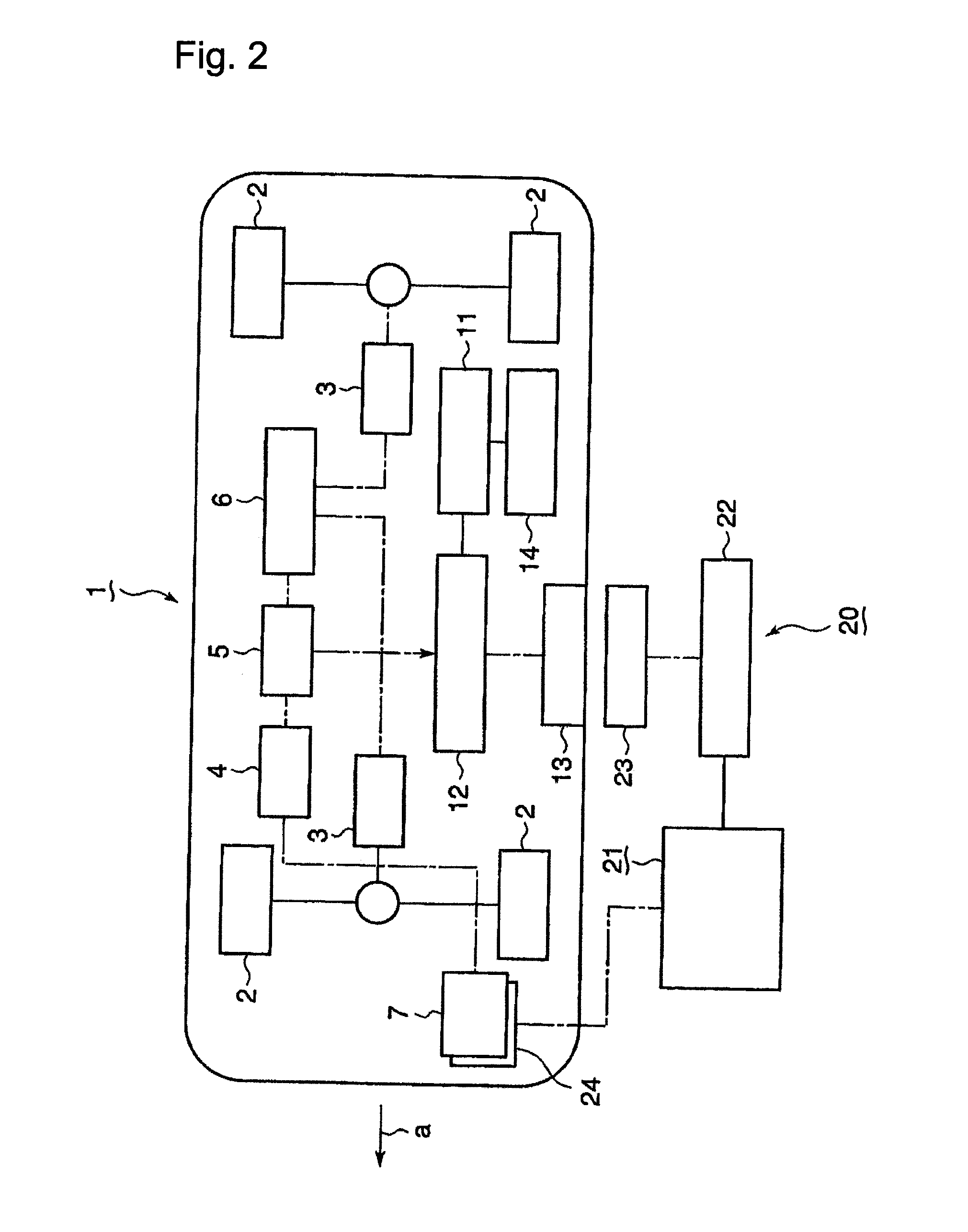Non-contact type power feeder system for mobile object
a feeder system and non-contact technology, applied in the direction of safety/protection circuits, rail devices, vehicle sub-unit features, etc., can solve the problems of system unsuitability for such a tract type, insufficient power charging, and a relatively long operation time, and achieve the effect of degree of design freedom
- Summary
- Abstract
- Description
- Claims
- Application Information
AI Technical Summary
Benefits of technology
Problems solved by technology
Method used
Image
Examples
embodiment 1
[0060]A first embodiment of the present invention will be explained with reference to FIGS. 1 to 5C.
[0061]Referring to FIG. 1, a vehicle 1 in a track type traffic system is an electric vehicle which is equipped with rubber tires 2 as wheels at four corners of the bottom of the vehicle, and adapted to run on a predetermined track (a running road surface 30 in this embodiment) under electric power.
[0062]Referring to FIG. 2, the vehicle 1 incorporates motors 3 for driving the rubber tires 2, a secondary storage cell (for example, a lithium ion secondary storage cell) 5 for feeding drive currents to the motors 3, and a controller 6 for controlling the motors 3. A power receiver 7 is provided in a front lower part of the vehicle 1, and an electric motive force induced in the power receiver 7 is converted by a rectifier 4 into a DC current which is then charged in the secondary storage cell 5.
[0063]Further, the vehicle 1 is mounted therein with a vehicle control unit 11 for controlling th...
embodiment 2
[0101]Next, explanation will be made of a second embodiment of the present invention with reference to FIG. 8 which is a side view illustrating a configuration of a vehicle in a track type traffic system in the second embodiment. Referring to FIG. 8, like reference numerals are used to denote parts having structures like to that of those explained in the first embodiment as stated above. These are also applied all subsequent figures which will be explained hereinbelow. In this embodiment, onboard power receivers 7a, 7b, 7c are arranged in three parts, such as the front, middle and rear parts of the vehicle 1, respectively, and ground power receivers 7a, 7b, 7c are provided on a running road surface 30 at three positions which are opposed face-to-face to the three onboard power receivers 7a, 7b, 7c of the vehicle 1 which has come to a stop. The onboard power receivers 7a, 7b, 7c are flat plate-like as explained in the first embodiment, and they can be easily arranged at places betwee...
embodiment 3
[0103]Next, explanation will be made of a third embodiment of the present invention with reference to FIG. 9 which is an elevation view illustrating a configuration of a vehicle stopped in a station or the like. Referring to FIG. 9, a ground power feeder 24 is provided onto a roof 63 which is supported by a support column 61 standing upright on a platform 61 in the station or the like. A power feed line 25 connected to a charging power source 21 is laid through the insides of the support column 62 and the roof 63, and is connected to the ground power feeder 24 through the intermediary of a ground charge control unit 22.
[0104]Meanwhile, a vehicle power receiver 7 which is provided on the upper surface of the roof of the vehicle is opposed face-to-face to the ground power feeder 24 with a predetermined gap therebetween when the vehicle 1 comes to a stop at the platform 61. In this embodiment, since the onboard power receiver 7 is flat plate-like, as stated above, it is easily mounted ...
PUM
 Login to View More
Login to View More Abstract
Description
Claims
Application Information
 Login to View More
Login to View More - R&D
- Intellectual Property
- Life Sciences
- Materials
- Tech Scout
- Unparalleled Data Quality
- Higher Quality Content
- 60% Fewer Hallucinations
Browse by: Latest US Patents, China's latest patents, Technical Efficacy Thesaurus, Application Domain, Technology Topic, Popular Technical Reports.
© 2025 PatSnap. All rights reserved.Legal|Privacy policy|Modern Slavery Act Transparency Statement|Sitemap|About US| Contact US: help@patsnap.com



